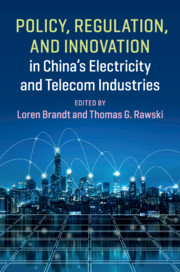Book contents
- Policy, Regulation, and Innovation in China’s Electricity and Telecom Industries
- Policy, Regulation, and Innovation in China’s Electricity and Telecom Industries
- Copyright page
- Contents
- Figures
- Tables
- Contributors
- Acknowledgments
- Abbreviations
- Map of China
- 1 Policy, Regulation, and Innovation in China’s Electricity and Telecom Industries
- 2 China’s Electricity and Communications Regulation in Global Context
- 3 Local Government and Firm Innovation in China’s Clean Energy Sector
- 4 Technology Integration in China’s Electricity System: Central Targets and Local Challenges
- 5 When Global Technology Meets Local Standards
- 6 The Search for High Power in China: State Grid Corporation of China
- 7 Growth, Upgrading, and Limited Catch-Up in China’s Semiconductor Industry
- 8 Growth, Upgrading, and Excess Cost in China’s Electric Power Sector
- 9 China’s Development of Wind and Solar Power
- 10 Capability Upgrading and Catch-Up in Civil Nuclear Power: The Case of China
- Index
- References
1 - Policy, Regulation, and Innovation in China’s Electricity and Telecom Industries
Published online by Cambridge University Press: 08 June 2019
- Policy, Regulation, and Innovation in China’s Electricity and Telecom Industries
- Policy, Regulation, and Innovation in China’s Electricity and Telecom Industries
- Copyright page
- Contents
- Figures
- Tables
- Contributors
- Acknowledgments
- Abbreviations
- Map of China
- 1 Policy, Regulation, and Innovation in China’s Electricity and Telecom Industries
- 2 China’s Electricity and Communications Regulation in Global Context
- 3 Local Government and Firm Innovation in China’s Clean Energy Sector
- 4 Technology Integration in China’s Electricity System: Central Targets and Local Challenges
- 5 When Global Technology Meets Local Standards
- 6 The Search for High Power in China: State Grid Corporation of China
- 7 Growth, Upgrading, and Limited Catch-Up in China’s Semiconductor Industry
- 8 Growth, Upgrading, and Excess Cost in China’s Electric Power Sector
- 9 China’s Development of Wind and Solar Power
- 10 Capability Upgrading and Catch-Up in Civil Nuclear Power: The Case of China
- Index
- References
Summary
China represents a new chapter in ongoing controversy over the use of state intervention to promote innovation and upgrading. This book analyzes the nature and outcome of recent Chinese efforts to accelerate progress toward global technology frontiers in electricity, telecommunications and semiconductors.
Our contributors document impressive absorption and upgrading of a wide array of technologies as well as individual instances of path-breaking innovation. Notable advances include achievement and even extension of global technical standards in particular segments of electricity transmission and thermal power generation along with rising competitive strength in global markets for conventional and nuclear electricity, telecom equipment and software.
We also observe instances – notably semiconductors and wind turbine equipment - in which government efforts to promote innovation have encountered difficulty in penetrating overseas (wind equipment) and even domestic (semiconductors) markets. In addition, we observe consistently high levels of excess capacity and operational inefficiency – for example, the average cost of generating and delivering each unit of electricity is at least 30 percent higher in China than in the United States
Recent initiatives center on the Made in China 2025 plan to develop an extensive array of advanced manufacturing industries. Current strategy emphasizes instruments – self-reliance, channeling resources toward state enterprises, top-down selection of strategic products and technologies and Party control – that have retarded productivity growth in the past, while moving away from openness, competition, private-sector expansion and other measures strongly associated with past increases in productivity.
Telecommunication equipment, a sector that has thrived in an environment of openness and competition, offers a strong contrast to the recent decline in productivity outcomes visible at the industry-wide level and in several electricity-related product categories. Current policies reinforce distorted incentives that can only expand the massive costs associated with excess investment, misallocation and corruption. These costs will act as a powerful counterweight to the extraordinary human, financial and policy resources that China’s leaders are now directing toward innovation and upgrading across a broad spectrum of industries.
Keywords
- Type
- Chapter
- Information
- Publisher: Cambridge University PressPrint publication year: 2019
References
- 1
- Cited by



